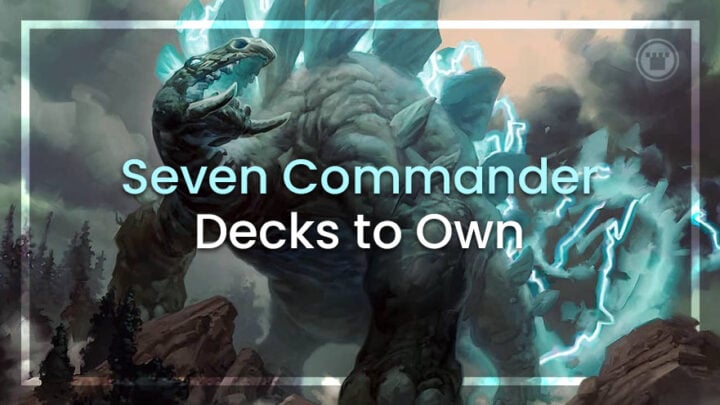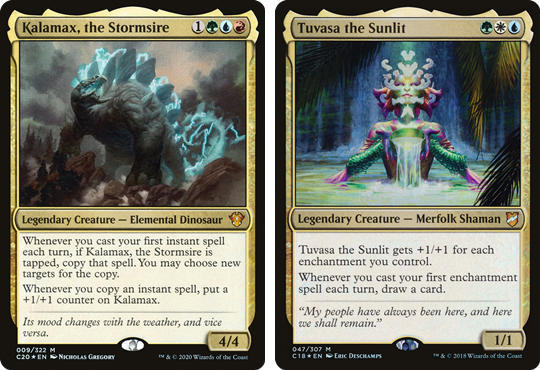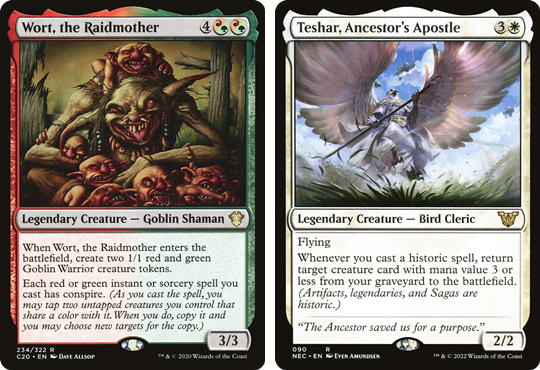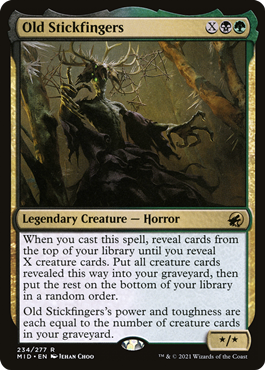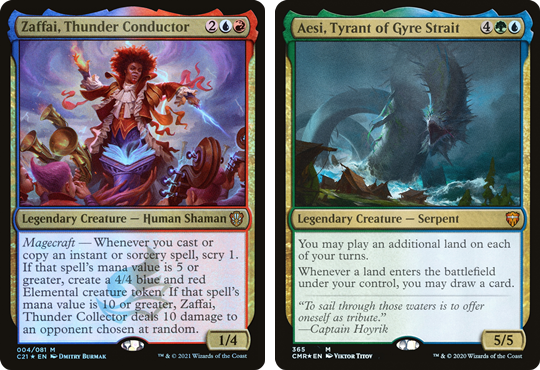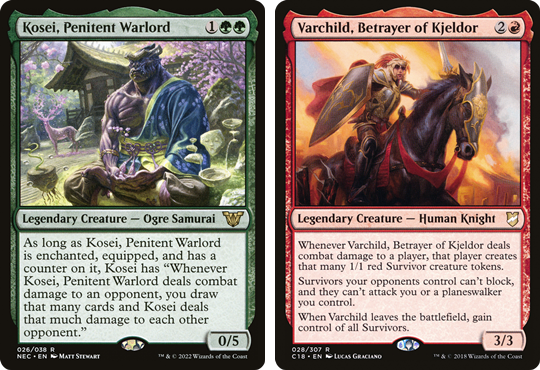Commander is, perhaps, the largest sandbox environment in gaming. There are countless commanders, cards and archetypes available — to the point where it’s impossible to build every combination. Many Commander players can struggle with this extreme level of choice, and decision paralysis is something I personally experience often when deciding on decks to build.
However, there is a sort of structure you can add to your deck building process that may help.
Today, I’ve broken Commander down into seven types of decks to consider when brewing. These groups are not tied to any particular archetype or strategy, but they provide a specific experience or fulfill a need that most players seek. I’ll be using my own decks as examples, as well as decks from my regular playgroup
Now, this isn’t to say that everyone should have seven decks — I know that’s not financially possible for everyone. These are just specific experiences that highlight some of the reasons why players love Commander, so not everyone will want all seven.
Some of these types can overlap in the same deck, too. So, if you build cleverly, you’ll be able to cut the number of individual decks down.
Every Deck Carry
When in doubt, take this deck out. It’s your safety blanket — your old reliable. You’re happy to run this into an unknown pod in a local game store, and you know it should fare well.
You know how to pull punches with it if it’s a bit strong for the table, or you’re happy to be the archenemy for a couple of turns. Conversely, if it turns out to be underpowered, you won’t mind because you’re having a blast playing it.
This kind of deck is usually “on brand” for the pilot. I love spellslinger decks, for example, so Kalamax, the Stormsire is my go-to deck. If you love enchantress decks, then Tuvasa the Sunlit might be your choice, or Syr Konrad, the Grim if you’re a graveyard player.
These kinds of deck often end up being a “forever deck” because they’re so enjoyable that you never tire of them. You can read my article about forever decks if you want some inspiration for what that might entail.
The Goldfish
Every player should have a deck that’s fun to goldfish. For many people, it can be a long wait between games with friends. Having a deck you can enjoy going through the motions with when solo can make a huge difference.
These can also be decks that are a little more complex, or take many game actions. They’re the kind of deck you play when you want to “scratch that itch” — decks that feel a little more challenging to pilot, but are rewarding to navigate.
I have a Wort, the Raidmother deck that is a more traditional, nondeterministic storm deck. I try to win by either amassing an abundance of mana for one large Fireball or I make many, smaller copies instead. It’s a tricky deck to pilot, but the feeling I get when I play with it makes the process worthwhile.
Similarly, I have a Teshar, Ancestor’s Apostle deck that’s focused on generating value through artifacts, and finding niche lines to deal with issues on board. Its wins have been described as “MacGyvering a Rube Goldberg machine out draft chaff artifacts,” and it brings me so much joy every time I play it.
Something Simple
Sometimes, you don’t want to put that much thought into playing the game. Maybe the vibes are good and you don’t want to disrupt that by taking a ten minute turn. You might also be on your third game of the night and running out of brain power from piloting your goldfish deck. That is when the simple choices are often the best.
Simple decks are the antithesis to the aforementioned goldfish decks. They’re easy to pilot, the turns don’t last long and they don’t need your full attention to play well.
They’re also perfect for when the game is secondary to the company. Commander is often a reason for friends to hang out with each other, and playing something straightforward allows room for the conversation to flow.
Just because they’re labeled as “simple” doesn’t mean they have to be boring, though. My Umori/Old Stickfingers deck is a creature-only deck that’s focused on graveyard value. It plays almost completely at sorcery speed, leaving me free on other turns to engage in the conversation.
It’s still a force to be reckoned with, however. It can grind with the best of them, and one-hit KO’s are relatively common through commander damage.
A Precon
Everyone knows what preconstructed decks are like. Sure, some of them are better than others, but they have been relatively balanced (especially over the past few years). There’s a lot to be said for sitting down at a table with unknown players knowing you’re all going to have a good, fair game.
They may be mostly intended as an introduction to Commander for newer inductees to the format, but they’re often just very solid decks. There have been many games where I’ve seen the Prismari Performance deck take down lovingly brewed decks, or the Reap the Tides precon take out an entire table with ease.
Precons are also a great choice if you’re a person who tends to play at a higher power level the rest of the time. After all, if you’re used to playing at a certain level, it can be difficult to completely switch gears in the deck building stage. Having a precon at the ready gives you a lower power option when you need it, without having to worry about brewing something that’s outside of your usual scope.
They’re easy to acquire, too. Almost every LGS will have some on their shelves, and they’re often well priced. They also need absolutely no maintenance or improvement, so you can keep one of these in your bag for years and continue to have a consistently enjoyable experience.
A Spectacle
We’ve all seen this kind of deck before. These are the wild, off-kilter decks that showcase the stranger and underrated aspects of the game. I was talking about this style of deck in last week’s article: decks run by strange commanders, or that may be outside their archetype’s usual colors. They could also be decks with heavy restrictions, or even ones built around rule zero.
I have Kosei, Penitent Warlord as my spectacle commander. He requires me to jump through a few hoops to reap the benefits. But when I succeed, it’s a sight to behold.
Most players are in awe when they play against him for the first time, as they quickly realize he’s effectively the green analog of Kediss, Emberclaw Familiar — but with a permanent Hunter’s Insight effect.
Spectacle decks don’t have to be as directly aggressive as Kosei, however. Any deck that alters the basic parameters of any given game fits into this category, like my good friend Jamie’s Varchild, Betrayer of Kjeldor deck.
It’s a mono red, group hug deck that freely gives resources to the whole table, with the primary aim being to accelerate the game and reveling in the chaos that ensues. It never fails to turn heads, and it always leads to an amusing game.
An Unsleeved Deck
I know some of you may already be reeling at the thought of this. It’s a fairly normal response when we’re all so used to sleeving every single deck. Yet, since growth begins at the end of your comfort zone, it means we’re going in the right direction.
Building and playing with a sleeveless deck has become much more popular lately, particularly on Magic Twitter. Rhystic Studies’ video “Dear Gonti, Love Sophie” sparked this trend, and it has spread like wildfire (or marmite, given its divisive reception).
In essence, playing with an unsleeved deck is the most “real” Magic experience possible. Many players grew up on playground decks — beat up piles of cards that have only ever touched asphalt, sticky fingers and the inside of a lunch bag. It’s horrifying to think of for some. But to those that lived it, that’s real Magic.
If, like me, you didn’t play Magic in this way, you may still get something from trying it. I made a Callaphe, Beloved of the Sea deck a while back, and after watching Rhystic Studies’ video, I promptly unsleeved it. It’s now my go-to deck for when I want to shock and entertain others (the reaction from others when I riffle shuffle it alone makes it worthwhile).
It also has a much smaller footprint, since an elastic band uses up much less space than a deck box. This now lives in the bottom of my satchel, ready for any chance encounter with other players. Truly, this deck plays as Garfield intended.
The Pièce de Résistance
Finally, at the opposite end to the unsleeved deck, is the pièce de résistance. This is your labor of love — the deck you care so much about that you want to make it stand out as truly your own.
For me, it’s my Laelia, the Blade Reforged deck. I’ve referenced this in several articles now, both as a showcase of red’s recent progress and growth and as my own forever deck. I have such a deep love for it that having the regular card versions in the deck doesn’t do it justice.
I’ll take any chance I get to replace cards in the ninety-nine with an alt art version, or a foil or Japanese printing. I’ve also been asking friends and fellow creators to sign their favorite card in the deck, since they’re the main reason I play. It’s my way of showing off my love for the deck, the game and everyone in it.
These pièce de résistancedecks don’t need to break the bank, though. Thanks to the huge influx of alternate arts and showcase frames, as well as incredible basic land treatments in each set now, it’s never been easier or more affordable to bling out a deck. As long as it feels right to you, it is right.
End Step
Commander is a unique and special experience for every player. With the right approach to brewing and the right choice of deck, you’ll find you can improve any game and leave a lasting impression that will have everyone involved walking away with a memorable experience.
If this has inspired your next masterpiece, you can tag me in them on Twitter. I’d love to see the fresh and exciting experiences you’re bringing to your next game night.

Scott is an Irish content creator and the Head of Budget Magic for the Izzet League. He focuses on affordable decks in Pioneer, Modern, and Pauper, particularly ones that stray from the mainstream. When he’s not writing about his favorite decks, he can be found talking incessantly about them on Twitter and on The Budget Magic Cast.

